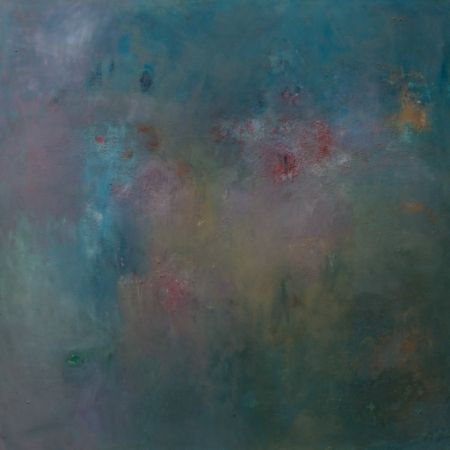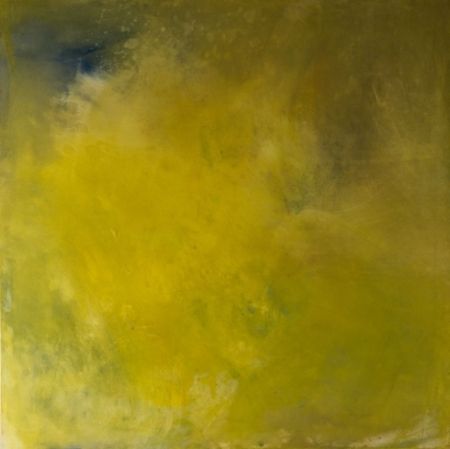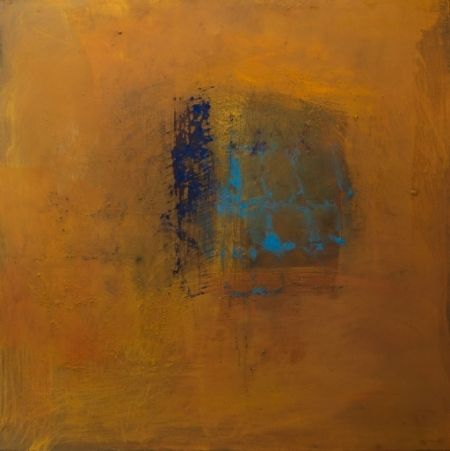FEATURES|COLUMNS|Dakini As Art (inactive)
Let It Be: Creativity in the Moment
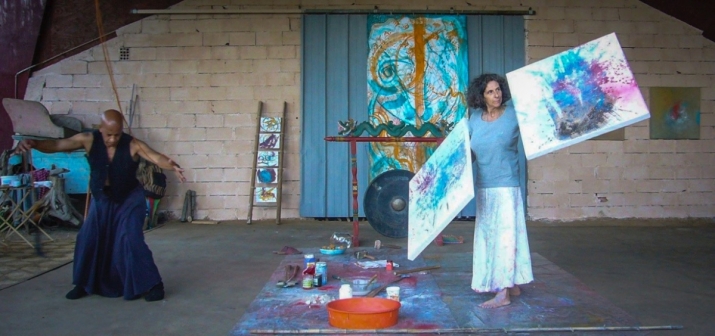 Zoe Redman working with Michel Raji
Zoe Redman working with Michel RajiFrom a very early age I’ve enjoyed spending time alone. As a young girl growing up in England, communing with nature, I would crush stones to see the beautiful colors inside, make potions out of rose petals, and speak in my own invented language to invisible friends. I think I’ve always felt that there was something much bigger than the material world we see around us.
At 16, I found a key that opened a door to new horizons: I left school to follow my passion and study contemporary art at Loughton College of Further Education. Having escaped a stifling middle-class background, my mind was blown open by what I was now learning. My tutors were young, radical, avant-garde artists who pushed us beyond our limitations, encouraging us to experiment and deeply question our “intention.” It was while exploring my creative process in the mid-1970s in London that I discovered the philosophy of “let it be: creativity in the moment.” I remember painting on large pieces of paper spread out on the floor and feeling an intense joy in the large gestures and movements—my heart was open, there was no going back. The whole world suddenly appeared much more spacious, and full of possibilities. At last, freedom and food for my hungry soul. By the 1980s, I was working as a video and performance artist, still living in London. Life was exciting, but with our home due to be demolished to make way for a motorway, my companion and I decided on a whim to move with our two small children to a rural area in southern France. Twenty-six years on, I still live in a beautiful valley in the same region.
I began following the Buddhist path soon after we moved into an abandoned water mill in an extraordinary valley in the middle of nowhere, in 1999. Almost immediately after the move, I fell extremely ill and was rushed to hospital with chronic asthma. The emergency doctor and his wife introduced me to a Tibetan lama—Lama Norbu Repa—who was setting up a Karma Kagyu center 20 minutes from where we lived. I took Refuge in January 2000 just at the time His Holiness the 17th Karmapa, Ogyen Trinley Dorje, left China for India, and spent the next 12 years helping and practicing at Theg-Chog Norbu Gatsal.
A visit to India in 2007–8 marked a turning point in my life. First, a meeting in Delhi with Tai Situ Rinpoche, a senior lama in the Karma Kagyu tradition, who encouraged my art practice, then the Karma Kagyu Monlam prayer festival with His Holiness the Karmapa in Bodh Gaya and completing my Ngöndro (the preliminary practices, involving Refuge and bodhichitta with prostrations, Vajrasattva purification practice, mandala offerings, and Guru Yoga). Attending Mahamundra teachings—the highest teachings in the Karma Kagyu tradition—with the respected teacher and master Yongey Mingyur Rinpoche, I experienced the same feeling I had had 30 years earlier when painting on the floor—that of freedom and spaciousness—as Rinpoche pointed out the nature of mind, instructing us to just “let it be.”
My experiences in India became the basis for my future art practice. Later in 2008, I began the 108 Doors project (later renamed 108)—a multimedia live improvisation named after the 108 beads on a Buddhist mala, or rosary—in collaboration with composer Mark Lockett and my son Jacob Redman, a videographer.
The first 108 event was at the opening of an exhibition of my paintings. It was an incredible feeling as an artist to paint on large canvases on the floor while immersed in projected images and music. I felt completely blind and totally vulnerable; all I could do was listen to the music Mark was creating while maintaining my concentration and discipline. I opened my senses, crushed my rocks, and poured my pigments, joining in with the music by tapping the canvases with my hands and rubbing them together. The painting seemed to take on life and become three-dimensional. Over the years, I have learned that if we are completely present in the moment and authentic in the creative process, the audience becomes captivated and moved by the simple human act of creation.
Since 2008, I have been in creative dialogue with composer and cellist Stanley Adler, who expresses his profound sensitivity through his music. His receptivity enables me to enter his universe and go deeply into spontaneous expression. In April this year, following a visit to Nepal, Stanley accompanied me on his cello in my studio in France as I created paintings using crushed rock from the Himalayas, red powders from Kathmandu, and cadmium yellow pigment. Also, the creative dialogues I’ve engaged in since 2010 with flamenco dancer and musician Metod Laurentius, who I met at the Mahamundra teachings in Bodh Gaya, have yielded some incredible synergetic experiences, during which we explored techniques to incorporate rhythm and movement based on flamenco into the process of painting and live improvisation.
This year, I’ve begun a compelling dialogue entitled Matières à l’oeuvre (Matter at Work) in collaboration with Laure Essinger, a visual artist who creates Japanese paper out of white vegetable fibers. While our work is diametrically opposed—hers clean and white, mine messy, crushing colored rocks found on my travels and mixing them with vibrant pigments—we created an “immersive” environment of artistic expression over a period of days in a beautiful chapel in a pine forest in the south of France. During a storm, water flooded the land around the chapel and the roof leaked, making holes in Laure’s drying paper, and in this way the chapel became an integral part of our creative process. There were poignant moments when Laure and I came together to make imprints from my paintings onto blank sheets of her paper, which were then hung. Our continuing creative process was open to viewing by the public on the last day, with the accompaniment of Stanley Adler on cello and video projections by Jacob Redman.
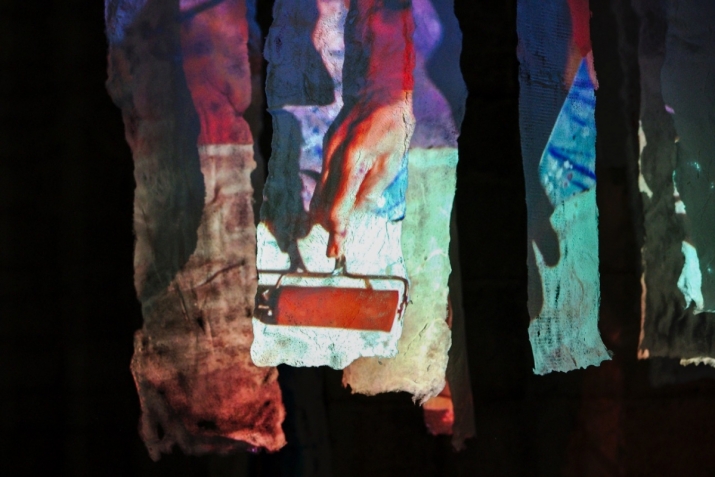 From Zoe Redman's installation Matières à l’oeuvre
From Zoe Redman's installation Matières à l’oeuvreI also feel honored to have had two creative encounters this year with the exceptional abstract performance artist Michel Raji, whose art is rooted in Sufism and the alchemy between dance, breath, and gesture. Through improvised dance, Michel seems to sculpt space, from the upright and vertical to horizontal to rotating on his own axis, in harmony with the universe. Turning myself and rubbing two paintings together in circular movements, I was amazed to see that the crushed rocks left circular marks on the canvases, resembling a map of the whirling dance or the orbits of planets spinning through space. On both of the occasions that Michel and I have worked together, he challenged me and pushed me beyond my comfort zone, making me explore places I had never been before. During a performance of 108, Michel completed his orbit and then sat immobile on a chair. What should I do? My mind fell apart as this was not what I had been expecting! I calmed myself and felt his presence and the space he was offering me, and continued until the end of my creative cycle, completing a triptych.
On our second encounter, Michel danced through a garden and then entered the space in which I was painting. Again the unexpected happened: he took my paintbrush, which was hanging from the ceiling, and danced with it in circular movements. I took the canvas and joined his movement as he painted. Being present in the moment with Raji is to align with cosmic geometry. Let it be!
Entering into fusion with matter,
Opening outwards and inwards towards the infinite
Until the “I” does not exist anymore
Zoe Redman is a member of the Dakini As Art Collective. To learn more about Zoe, her work, and Dakini As Art, please visit Dakini As Art.
See more
Zoe Redman (Dakini as Art)
Michel Raji (Dakini as Art)
Laure Essinger
Mark Lockett
Stanley Adler

